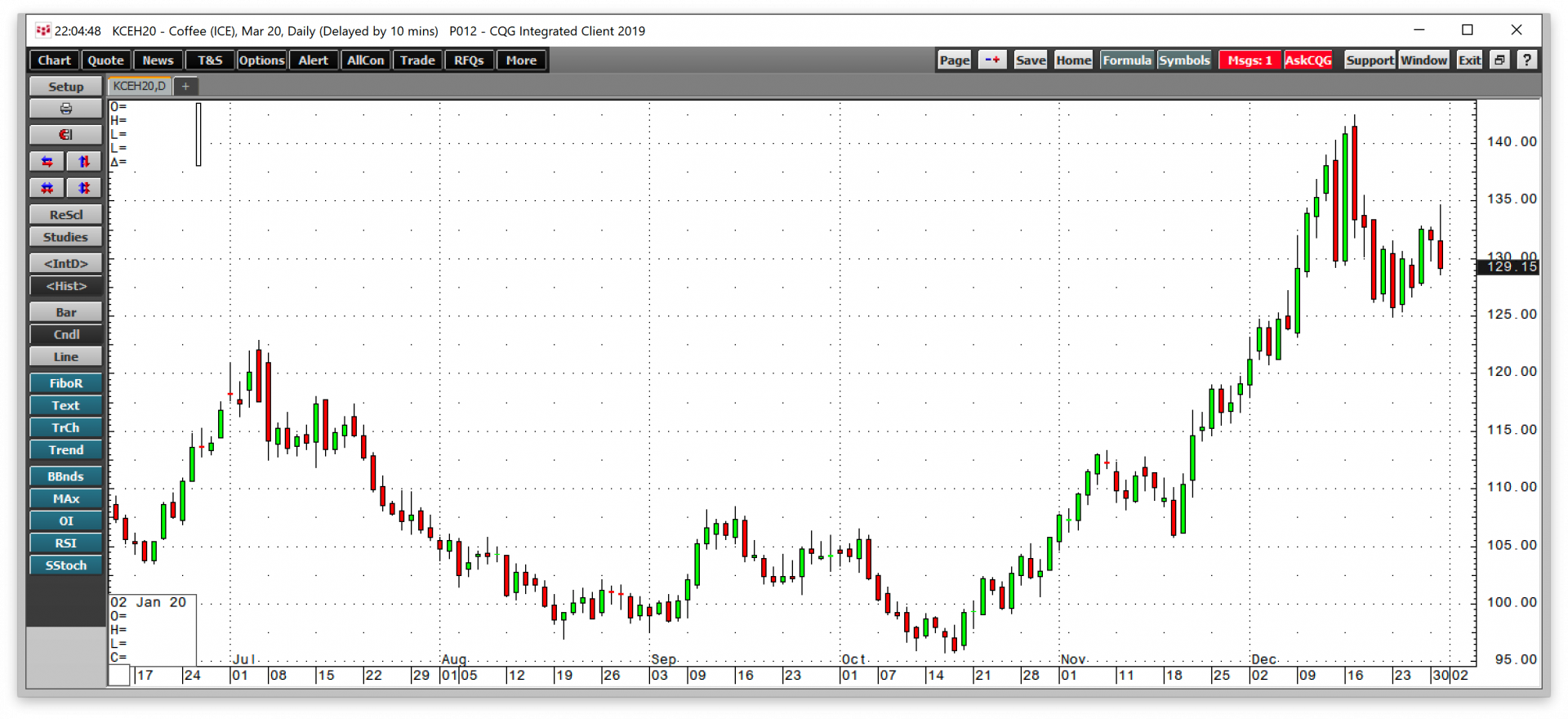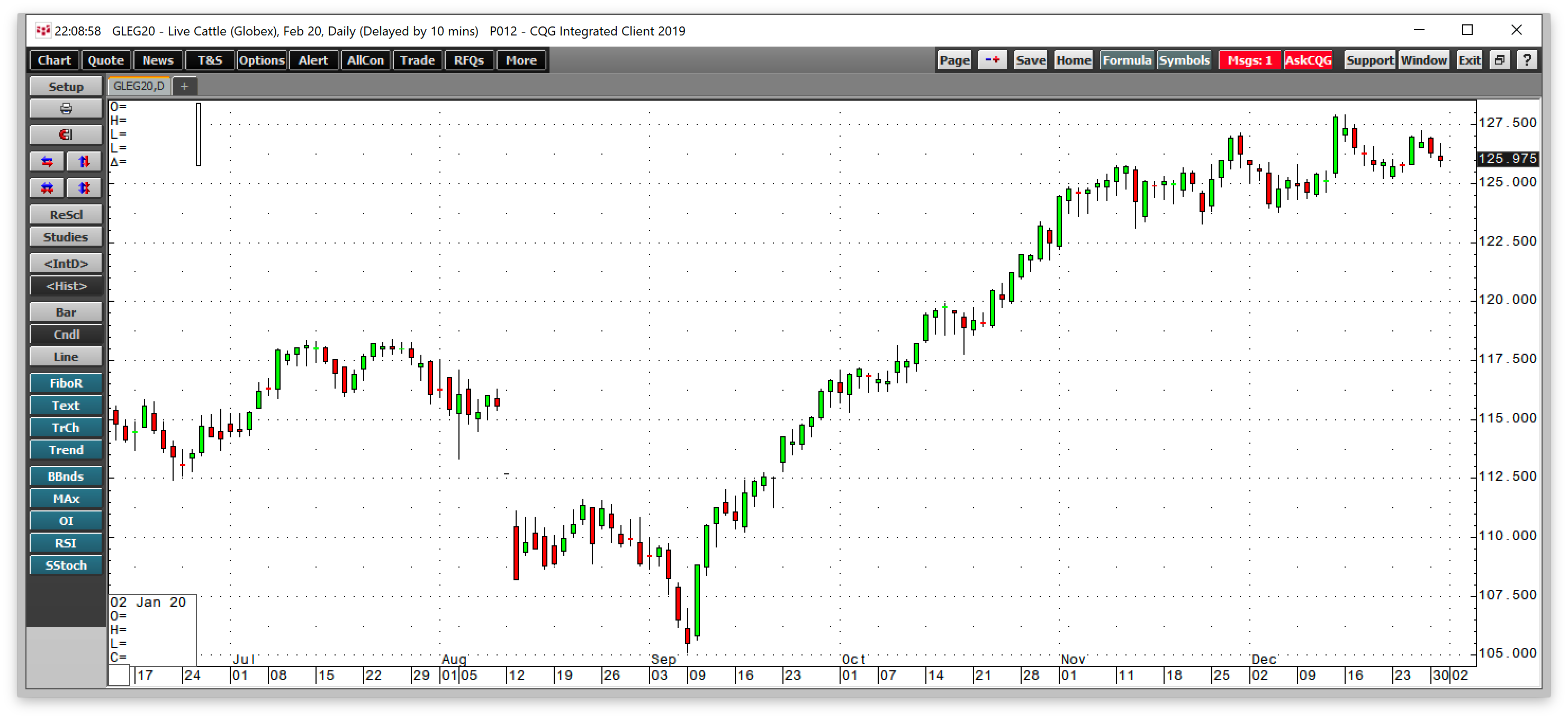A weaker dollar and de-escalation in the trade war between the US and China lifted commodity prices in the final quarter of 2019. In Q4, a composite of 27 commodities prices that trade on the futures exchange in the US and forward exchange in the UK appreciated by 6.47%. In 2019, the asset class posted a 10.98% gain as of the close of business on December 31.
At the same time, the stock market moved appreciably higher in 2019, after the price carnage during the final quarter of 2018. The DJIA was up better than 22% for the year, with the S&P 500 gaining almost 29%. The tech-heavy NASDAQ moved over 35% higher on a year-on-year basis. The US 30-Year Treasury bond futures moved nearly 6.8% higher as the Fed reduced the short-term Fed Funds rate by 75 basis points and ended its balance sheet normalization program. The dollar index did not move all that much in 2019, as it rose by only 0.34%.
As we head into a new decade, a myriad of issues will continue to confront markets across all asset classes, and commodities are no exception. We head into 2020 with optimism on the trade front, given the “phase one” deal between the US and China. At the same time, the UK election on December 12 paved the way for a Brexit with an agreement in January. Meanwhile, Iran continues to be a problem in the Middle East. Liquidity from accommodative central bank policies around the world continues to flood the markets. North Korea started making belligerent noises at the end of the year. And, the US Presidential contest could be the most contentious in history. All of these issues, as well as the unknown, are likely to cause volatility in markets at the start of the roaring twenties, the 2020’s.
Five sectors gain, and one posts a loss in Q4
During the fourth quarter, we saw gains outnumber losses. Five of the six primary segments of the commodities asset class posted an increase in Q4. The top two performing commodities for Q4 were coffee, which appreciated by 28.23% and live cattle futures, which were up 19.24%. There was a total of twelve double-digit percentage gainers in Q4.
In Q4, soft commodities led the asset class with an 11.57% gain, followed by animal proteins that were 10.14% higher since the end of September 2019.
On a year-on-year basis, all six of the sectors posted gains with precious metals leading the way with a 28.93% gain driven by an almost 59.50% rise in the price of palladium. Meanwhile, gold, silver, and platinum all posted double-digit percentage price increases from the end of 2018. Gold broke out to the upside in June and remained above critical support throughout the rest of the year. Energy won the silver medal in the asset class with a 15.11% increase. NYMEX crude oil futures led the sector with a 34.46% gain on the year. Grains moved 11.50% higher, while animal proteins were 5.15% higher for 2019. Soft commodities eked out a 3.47% gain thanks to its leadership on the upside in Q4. Base metals moved 1.74% higher on the year thanks to an over 31% gain in the price of nickel.
No sectors posted a loss for 2019.
Coffee is the leader on the upside with live cattle in second place in Q4
The coffee and live cattle markets were star performers in Q4.
 As the chart highlights, March coffee futures moved from $1.0425 to $129.15 per ton in Q4. March coffee traded as high as $1.4245 on December 17, the highest price since 2017, before pulling back a bit at the end of December. The International Coffee Organization told the market that because of an off-year in Brazilian Arabica production, a deficit between supplies and demand could develop.
As the chart highlights, March coffee futures moved from $1.0425 to $129.15 per ton in Q4. March coffee traded as high as $1.4245 on December 17, the highest price since 2017, before pulling back a bit at the end of December. The International Coffee Organization told the market that because of an off-year in Brazilian Arabica production, a deficit between supplies and demand could develop.
Live cattle took the silver medal in performance with a 19.24% gain over the three months.
 The chart shows that nearby February live cattle futures on the CME rose from $1.16625 at the end of September to $1.25975 per ounce at the end of Q4.
The chart shows that nearby February live cattle futures on the CME rose from $1.16625 at the end of September to $1.25975 per ounce at the end of Q4.
Soft commodities are the best-performing sector for the quarter, but precious metals led for the year
The soft commodity sector was the leader over the three-months with double-digit percentage gains in coffee, cotton, and sugar. Coffee gained 28.23%, while cotton was 15.56% higher. Sugar futures moved 12.58% higher in Q4. All three commodities were near the bottom end of their respective pricing cycles earlier in the year and 2018 and were overdue for recoveries.
Precious metals shined brightly in 2019. Palladium was a bullish beast posting a 59.48% gain on the year. Platinum was 22.05% higher, and gold appreciated by 18.87%. Silver was the worst-performing precious metal, but it managed a 15.32% increase on a year-on-year basis.
Falling interest rates in the US and around the world lower the cost of carrying inventories, which is a supportive factor for prices. The asset class posted a double-digit percentage gain in 2019.
Base metals was the worst-performing sector in Q4 and on the year, but there were some bright spots
The biggest loser in Q4 was base metals as it declined by 1.56% over the three-months, led by an almost 19% loss in nickel forwards. While LME lead was 7.50% lower and zinc fell 1.36%, copper, aluminum, and tin prices all moved higher over the three months. Base metals posted a small gain on the year.
The three worst-performing commodities of Q4 were the Baltic Dry Index, which was down by 41.30%, nickel forwards that dropped 18.97%, and ethanol futures that declined 12.53%. The three suffered double-digit percentage losses for the quarter.
While no sectors posted a loss, natural gas fell 25.54% on the year. FCOJ fell 22.33%. the Baltic Dry Index was 14.24% lower, and LME tin dropped 13.26% rounding out the double-digit percentage losers on the year.
Gasoline and heating oil processing spreads reflected seasonal factors during the off-peak season of demand for gasoline in Q4. Gasoline cracks moved 14.30% lower while heating oil cracks, which are a proxy for distillate products, posted a smaller 6.60% gain at the end of the fourth quarter compared to their closing prices at the end of Q3 2019.
The cryptocurrency asset class moved a lower in the fourth quarter. Bitcoin lost 12.79% in Q4 and closed at the $7,226.77 level. The market cap of the asset class as a whole moved from $220.249 billion at the end of Q3 to $191.935 billion on December 31, down 12.86% for the three-months as Bitcoin kept pace with the other tokens in the final quarter of 2019. Ethereum posted a 26.79% loss in Q4, while Litecoin was 25.30% lower for the period. Bitcoin Cash was 9.55% lower.
Looking forward to Q4 and beyond in commodities
The commodities markets will be facing a myriad of issues in 2020. Optimism on trade between the US and China could quickly sour if things do not go according to plans over the “phase one” agreement. Tariffs create gluts in one region and shortages in others, as we have witnessed in the US and China in the agricultural sector.
Iran and North Korea continue to be trouble spots that could disrupt markets and cause periods of fear and uncertainty. The impeachment of President Trump on December 18 will lead to a trial in the Senate in January. Since not a single Republican in the House voted in favor of impeachment, an acquittal in the Senate is almost a sure thing. However, the Presidential election in November 2020 promises to be the most contentious, perhaps in history.
At the end of 2019, no candidate has emerged as a clear frontrunner to capture the Democrat’s nomination. The progressive wing of the party has significant support. Senators Sanders and Warren together have a larger percentage in the national polls than the leader former Vice President Joe Biden. The party will likely adopt policies like the “Green New Deal” that would change the landscape for fossil fuels in the United States. Other policies on the platform are likely to include higher taxes and a more stringent regulatory environment. Growing support for “Democratic Socialism” in the US could result in a wealth tax that has the backing of both Bernie Sanders and Elizabeth Warren.
The election will be not only a referendum on President Trump’s performance, but the future path of tax, energy, and other policies for 2021 and beyond. The bottom line is that more than a few issues and the unknown could trigger risk-off periods in markets across all asset classes, and commodities are no exception. Fasten your seatbelts for a wild year.